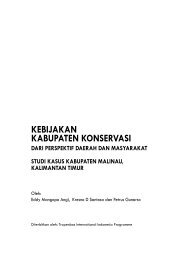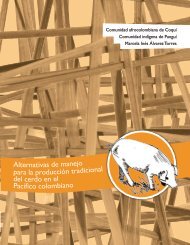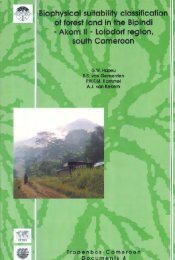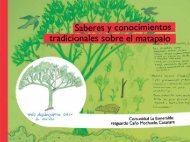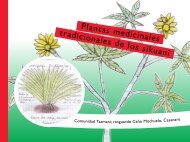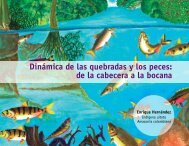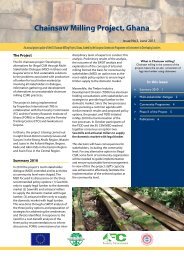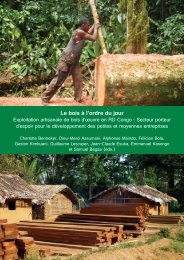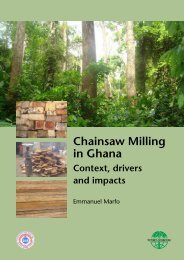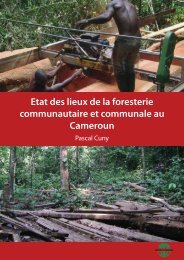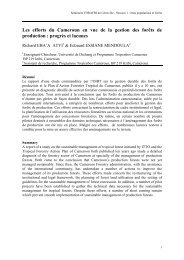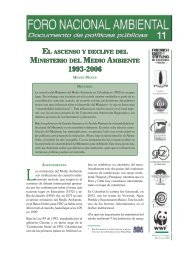Download the publication - Tropenbos International
Download the publication - Tropenbos International
Download the publication - Tropenbos International
Create successful ePaper yourself
Turn your PDF publications into a flip-book with our unique Google optimized e-Paper software.
General introduction<br />
areas of easy accessibility. Fur<strong>the</strong>rmore <strong>the</strong> output was often ra<strong>the</strong>r descriptive and<br />
aiming at <strong>the</strong> provision of rapid baseline information necessary for a sustainable<br />
management of <strong>the</strong> Campo Faunal Reserve. Therefore, <strong>the</strong> present study is <strong>the</strong> first<br />
systematic attempt to assess <strong>the</strong> botanical diversity of <strong>the</strong> Campo-Ma’an area in<br />
order to identify, locate and map hotspots for biodiversity conservation.<br />
1.4. BOTANICAL AND ECOLOGICAL ASSESSMENT METHODS<br />
In a large, heterogeneous and structurally complex forest ecosystem such as <strong>the</strong><br />
Campo-Ma’an tropical rain forest, conservation cannot proceed without a thorough<br />
understanding of <strong>the</strong> components of <strong>the</strong> ecosystems that are to be preserved. We<br />
need to know what are <strong>the</strong> species of high conservation priorities and where are <strong>the</strong>y<br />
located, so that we can target conservation resources to <strong>the</strong>se locations. Therefore,<br />
an inventory or biological stocktaking is requisite for all conservation initiatives.<br />
However, <strong>the</strong> selection of <strong>the</strong> most appropriate methods for <strong>the</strong> rapid assessment of<br />
forest ecosystems is always a difficult matter, and a series of questions need to be<br />
addressed to decide on <strong>the</strong> best approach to be taken. Some of <strong>the</strong>se questions are:<br />
• What are <strong>the</strong> specific objectives, priorities and concerns?<br />
• What information is available, essential and useful?<br />
• How can <strong>the</strong> information needed be provided?<br />
• How can it be recorded, analysed, reported and used?<br />
• What limitations and problems can be perceived?<br />
Fur<strong>the</strong>rmore, <strong>the</strong> traditional approaches of forest inventory are not sufficient for<br />
biodiversity assessment, because <strong>the</strong>y are mainly limited to tree species (especially<br />
timber-sized trees), which are assumed to reflect <strong>the</strong> forest floristic composition and<br />
physical structure. More often, taxonomic attention is weak for o<strong>the</strong>r growth forms<br />
such as shrubs, small trees, herbs and epiphytes, and despite a widely accepted<br />
recommendation that herbarium specimens should be routinely collected, this is<br />
done very rarely, if at all. Therefore, to be effective, a botanical assessment method<br />
that provides both quantitative and qualitative information was used during our<br />
study.<br />
Sampling criteria and field methods<br />
After a literature review of existing botanical work done in <strong>the</strong> area, a study of aerial<br />
photographs, satellite images, topographic and vegetation maps, a preliminary<br />
reconnaissance trip was carried out in <strong>the</strong> study area to identify representative and<br />
homogeneous vegetation types for sampling. These representative vegetation types<br />
were selected subjectively on <strong>the</strong> basis of physical and human factors such as<br />
climate (especially rainfall), altitude, slope, soils, <strong>the</strong> proximity to <strong>the</strong> sea and degree<br />
of forest use. Two types of samples were used during <strong>the</strong> assessment, <strong>the</strong> measured<br />
samples and <strong>the</strong> qualitative samples. The measured samples provided quantitative<br />
information on stand structure and composition of <strong>the</strong> forest, while qualitative<br />
information on species richness, life form and guild was provided by <strong>the</strong> qualitative<br />
samples.<br />
11



